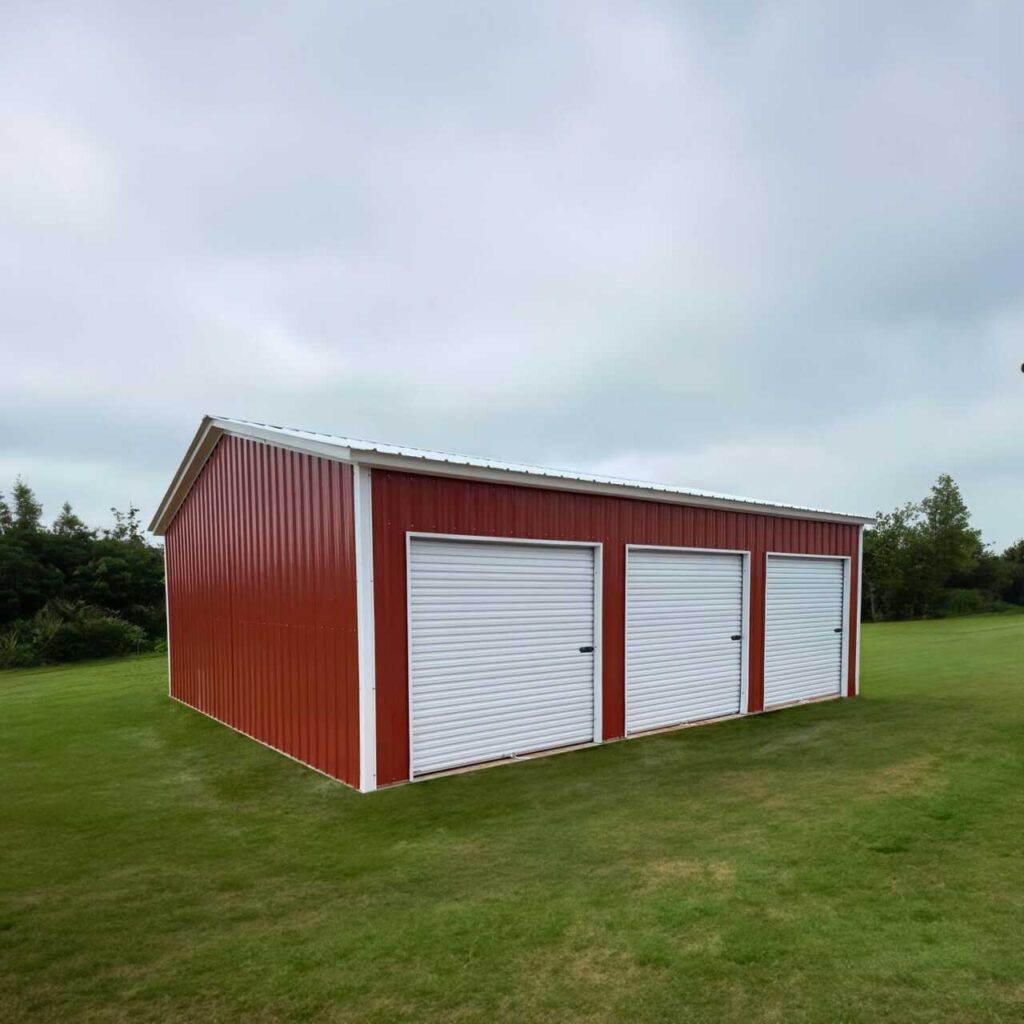
Contents
When considering the design of environmentally friendly metal buildings, it’s essential to explore creative approaches that embrace sustainability. By incorporating a range of green strategies, from eco-friendly roofing options to energy-efficient insulation choices, you can greatly diminish the environmental footprint of your construction project. These methods benefit the planet and contribute to long-lasting cost savings and enhanced occupant comfort. As you navigate the complexities of eco-conscious building design, you’ll uncover many opportunities to create structures that harmonize with nature and advance a greener future.
Key Takeaways
- Incorporate recycled metal for sustainability and reduced environmental impact.
- Opt for cool roof options to decrease heat absorption and energy consumption.
- Use high-quality insulation materials for energy efficiency and cost savings.
- Implement natural lighting strategies to reduce reliance on artificial lighting.
- Ensure correct installation techniques for long-term durability and performance.
Sustainable Roofing Options
When selecting eco-friendly roofing choices for green metal buildings, consider including materials like recycled metal or reflective coatings to enhance energy efficiency. Cool roof options and eco-friendly coatings can markedly diminish the heat absorbed by the building, resulting in lower energy costs and reduced environmental impact.
Alongside the materials used, rainwater harvesting systems can be integrated into the roofing design to promote sustainability further.
Cool roof choices, such as metal roofs with reflective coatings, are engineered to reflect more sunlight and absorb less heat than traditional roofing materials. By opting for these choices, you can lessen the heat transferred into the building, decreasing the necessity for excessive air conditioning and ultimately reducing energy consumption.
Integrating rainwater harvesting systems into the roofing design of your green metal building is another exceptional eco-friendly decision. These systems collect rainwater runoff from the roof, which can then be stored and utilized for irrigation, flushing toilets, or other non-potable water requirements.
Rainwater harvesting decreases reliance on municipal water supplies and helps prevent stormwater runoff, which can transport pollutants into water bodies.
Energy-Efficient Insulation Choices
Consider incorporating advanced insulation materials like spray foam or cellulose to enhance energy efficiency in your eco-friendly metal building design. Choosing the right insulation materials can significantly impact your building’s overall energy consumption, leading to cost savings and a reduced environmental footprint.
Here are some key points to keep in mind when selecting energy-efficient insulation options:
Insulation Materials: Opt for high-quality insulation materials such as spray foam or cellulose, which offer superior thermal performance and can help regulate indoor temperatures more effectively.
Energy Efficiency: By investing in proper insulation, you can improve the energy efficiency of your metal building, reducing the need for heating and cooling systems and lowering your overall energy costs.
Installation Techniques: Make sure that the insulation is installed correctly to maximize its effectiveness. Proper installation techniques can prevent air leakage and thermal bridging, further enhancing energy efficiency.
Cost Savings: While advanced insulation materials may have a higher upfront cost, the long-term savings in energy bills make them a cost-effective choice for eco-friendly building designs.
Environmental Impact: Energy-efficient insulation not just benefits your wallet but also contributes to a greener environment by reducing energy consumption and greenhouse gas emissions.
Daylighting Strategies for Efficiency
Enhance the energy efficiency of your eco-friendly metal building design by incorporating strategic daylighting strategies for top performance. Proper skylight placement and utilizing natural ventilation can greatly impact the overall efficiency and sustainability of your building.
When designing your metal building, consider the placement of skylights to maximize natural light entry. Skylights should be strategically located to allow for the best daylight penetration while minimizing heat gain or loss. Placing skylights on the north-facing roof slopes can provide consistent natural light without the harsh glare or heat associated with direct sunlight.
Incorporating natural ventilation systems into your metal building design can further improve energy efficiency. Utilizing features such as operable windows, vents, or clerestory windows can promote airflow, reducing the need for mechanical cooling systems during moderate weather conditions.
Here is a helpful table outlining key considerations for skylight placement and natural ventilation strategies:
| Skylight Placement | Natural Ventilation |
|---|---|
| North-facing roof slopes for consistent light | Operable windows for airflow control |
| Avoiding direct sunlight to minimize heat gain | Vents to release hot air and circulate fresh air |
| Consideration of building orientation for top results | Clerestory windows for improved air circulation |
Recycled Materials for Construction
Utilize reclaimed materials in your metal building construction to enhance eco-friendly practices and reduce environmental impact. Incorporating recycled materials into your construction project helps reduce waste and promote environmentally conscious design.
Here are some creative construction techniques and eco-friendly construction methods to explore:
Salvaged Wood: Reclaimed wood from old barns, factories, or even wine barrels can add warmth and character to your metal building while reducing the need for new timber.
Recycled Metal: Using salvaged metal from sources like old cars or appliances can be a durable and environmentally friendly option for roofing, siding, or structural components.
Upcycled Bricks: Reusing bricks from demolished buildings gives your metal structure a unique aesthetic and reduces the energy consumption required for brick manufacturing.
Repurposed Glass: Incorporating reclaimed glass into your design can enhance natural light penetration, reducing the need for artificial lighting and improving energy efficiency.
Recycled Insulation: Opting for insulation made from recycled materials like denim, cellulose, or even recycled fiberglass can improve thermal performance and contribute to a healthier indoor environment.
Water Conservation Techniques
Implement water conservation techniques that align with environmentally mindful practices to further enhance the long-term viability of your eco-conscious metal building project. Two key strategies to explore are rainwater harvesting and greywater recycling.
Rainwater harvesting involves collecting rainwater from the roof of your metal building and storing it for later use. This collected rainwater can then be used for irrigation, flushing toilets, or even for cooling systems within your building. By utilizing rainwater in this manner, you can significantly decrease your reliance on municipal water sources, leading to both cost savings and a reduced environmental impact.
Greywater recycling is another effective technique that involves reusing water from sinks, showers, and laundry activities for non-potable purposes. Instead of letting this water go to waste, greywater recycling systems treat the water to remove impurities and then repurpose it for tasks like landscaping, irrigation, or toilet flushing. By incorporating greywater recycling in your eco-conscious metal building, you can further decrease your overall water consumption and contribute to a more environmentally friendly water management approach.
Green Facade Solutions
With green facade solutions, you can transform the exterior of your metal building into a long-lasting oasis. Incorporating plant-covered walls can enhance the aesthetics and environmental performance of your structure.
Consider the benefits of integrating solar panels smoothly into your facade design to harness renewable energy efficiently.
Additionally, using recycled materials to construct your building’s exterior can reduce its environmental impact.
Plant-Covered Walls
Incorporating plant-clad walls, also known as green facade solutions, can greatly enhance the enduring and aesthetic appeal of metal buildings. Vertical gardens provide a natural touch to the industrial look of metal structures, offering a harmonious blend of nature and architecture. Living walls contribute to enduring aesthetics and promote biophilic design, fostering a connection to the natural environment.
Here are some key benefits of plant-clad walls:
Improved Air Quality: Plants act as natural filters, removing pollutants and releasing oxygen into the air.
Energy Efficiency: Green facades provide natural insulation, reducing the need for artificial heating and cooling.
Biodiversity Support: Living walls attract birds, insects, and other wildlife, creating a more diverse ecosystem.
Noise Reduction: Plant-clad walls help absorb sound, making the building environment quieter and more peaceful.
Visual Appeal: The vibrant colors and textures of plants enhance the overall beauty of the building, creating a welcoming atmosphere.
Solar Panel Integration
Integrating solar panels into green facade solutions enhances the durability and energy efficiency of metal buildings, providing a dual benefit of eco-friendliness and cost savings. When considering solar panel integration, choosing cost-efficient installation methods ensures that you achieve peak efficiency without breaking the bank. Solar panels contribute to eco-friendly energy practices and offer an aesthetically pleasing design, blending harmoniously into the facade of the building. This dual functionality of providing energy while enhancing the building’s visual appeal highlights the versatility and practicality of solar panel integration in metal buildings.
| Benefits | Description |
|---|---|
| Economical Installation | Implementing solar panels in a budget-friendly manner without compromising efficiency. |
| Peak Efficiency | Ensuring that the solar panels are operating at their highest capacity for energy generation. |
| Visually Attractive Design | Creating an aesthetically pleasing facade by smoothly integrating solar panels. |
| Renewable Energy | Harnessing renewable energy sources to power the building while reducing carbon footprint. |
Recycled Materials Incorporation
When employing green facade solutions in metal buildings, consider creatively repurposing reused materials to enhance eco-friendliness and minimize environmental impact. Incorporating reused materials decreases waste and adds a unique touch to your building design.
Here are some ideas to inspire you:
Upcycled furniture: Utilize old materials like salvaged wood or metal to create stylish and eco-friendly furniture pieces for your metal building.
Repurposed decor: Transform discarded items into decorative elements such as wall art, light fixtures, or sculptures to add character to your space.
Recycled glass: Integrate reused glass panels or tiles into your building’s facade to introduce natural light while reducing energy consumption.
Tire planters: Use old tires as planters for greenery around your metal building, adding a touch of greenery and promoting an eco-conscious lifestyle.
Pallet walls: Construct interior or exterior walls using pallets to give a rustic and environmentally friendly look to your metal building.
Custom Solar Panel Integration
When contemplating custom solar panel integration for your metal building, focus on strategic placement to maximize sunlight exposure.
Enhancing efficiency and output should be a priority in your design to ensure peak energy generation.
Integrate solar panels effortlessly into the overall aesthetic and functionality of your building for a harmonious and eco-friendly design.
Solar Panel Placement
To enhance energy generation and efficiency in your eco-friendly metal building, contemplate strategically placing custom solar panels on the structure’s roof and walls. Proper solar panel placement is essential for maximizing energy production and reducing maintenance needs.
Here are some key factors to ponder:
Shading Analysis: Conduct a thorough shading analysis to identify areas where shadows from nearby structures or trees may impact solar panel efficiency.
Best Positioning: Place solar panels in locations that receive maximum sunlight throughout the day to ensure peak energy generation.
Regular Upkeep: To ensure long-term performance, consider the maintenance requirements of the solar panels, such as cleaning and inspections.
Energy Storage: Consider integrating energy storage solutions like batteries to store excess energy generated by the solar panels for later use.
Professional Consultation: Seek advice from solar panel experts to determine the optimal placement strategy for your specific building and location.
Efficiency and Output
Boosting the efficiency and output of your eco-friendly metal building’s custom solar panel integration entails optimizing placement and technology choices to maximize energy production and minimize waste. By strategically installing solar panels in areas with optimal sunlight exposure and utilizing the latest renewable energy sources, such as green power, you can significantly enhance energy generation while reducing your carbon footprint. Additionally, incorporating energy-saving appliances and smart technology within your building can further amplify energy efficiency, ensuring that your structure operates at peak performance while being environmentally conscious.
| Technology Choices | Placement Optimization | Energy Production | Waste Minimization |
|---|---|---|---|
| High-efficiency Panels | Sunlight Analysis | Maximized Output | Recycling Programs |
| Smart Inverters | Roof Angle Adjustment | Increased Efficiency | Energy Monitoring |
| Battery Storage Systems | Shading Prevention | Peak Performance | Minimized Loss |
Integration With Design
For the best outcomes in custom solar panel integration, consider aligning the design of your eco-conscious metal building with the placement and technology choices to maximize energy production and efficiency.
Incorporating environmentally friendly architecture principles and green building standards can enhance the overall performance of your solar panels. Here are some key considerations for integrating custom solar panels smoothly into your metal building design:
Biophilic design: Integrate natural elements like plants and greenery into the building design to create a harmonious environment that complements solar panel installation.
Efficient placement: Strategically place solar panels to capture maximum sunlight throughout the day, optimizing energy production.
Technology compatibility: Ensure that the solar panel technology chosen is suitable with the design of the metal building for effortless integration.
Eco-conscious landscaping: Surround the building with sustainable landscaping that complements the solar panels and enhances energy efficiency.
Maintenance access: Design the building layout to provide easy access for maintenance and cleaning of the solar panels, ensuring top performance.
Passive Cooling Design Elements
Implementing strategic shading techniques and integrating natural ventilation systems are essential passive cooling design elements for eco-friendly metal buildings. Natural ventilation plays a vital role in maintaining a comfortable indoor environment while decreasing the need for mechanical cooling systems.
By strategically positioning windows, vents, and louvers, you can maximize airflow throughout the building, promoting cross ventilation and minimizing the reliance on energy-intensive air conditioning.
Shading techniques are equally important in passive cooling design. Features such as overhangs, awnings, and vegetation can help block direct sunlight from entering the building, thus reducing heat gain. Providing adequate shading, especially on the building’s east and west sides, can greatly decrease the cooling load and improve overall thermal comfort for occupants.
Incorporating natural ventilation and shading techniques enhances the sustainability of metal buildings and fosters a healthier and more pleasant indoor environment.
These passive cooling strategies reduce energy consumption and operational costs and contribute to a more sustainable and eco-friendly building design.
Green Certification Programs
By enhancing the longevity of your metal building through green certification programs, you can effectively communicate its eco-friendly features to stakeholders and potential occupants. Achieving green building standards and certifications validates your commitment to reducing environmental impact while highlighting the eco-conscious construction techniques and energy-saving measures incorporated into your building design.
Here are some key benefits of enrolling in green certification programs:
Credibility: Certification from recognized programs enhances your building’s credibility in the eyes of environmentally conscious stakeholders.
Marketability: Green certifications make your metal building more attractive to tenants seeking eco-friendly spaces, potentially boosting occupancy rates.
Cost Savings: Implementing eco-friendly practices benefits the environment and can also lead to long-term cost savings through reduced energy consumption.
Compliance: Green certification programs often align with local regulations, ensuring your building meets or exceeds environmental standards.
Innovation: By adhering to green building standards, you showcase a commitment to innovation and responsible construction practices, setting your metal building apart in the market.
Enrolling in green certification programs is a proactive step towards demonstrating your metal building’s environmental stewardship and fostering a sense of belonging within the eco-conscious community.
Review
You’ve now revealed the key to designing eco-friendly metal buildings. By incorporating durable roofing, energy-efficient insulation, and green facade solutions, you can create a structure that diminishes environmental impact and promotes sustainability.
Remember, in eco-friendly design, every choice you make is like a brushstroke on a canvas – each one contributing to the masterpiece of a greener future.
So go forth and build with purpose!
Recent Posts
Explore Benefits of Residential Metal Structures
It’s funny how you might stumble upon the idea of residential metal structures just when
5 Best Durable Metal Garages for Longevity
Imagine your garage as the backbone of your property, supporting everything from tools to vehicles,
3 Tips for Durable Metal Garages
Is it true that the longevity of your metal garages hinges on just a few




